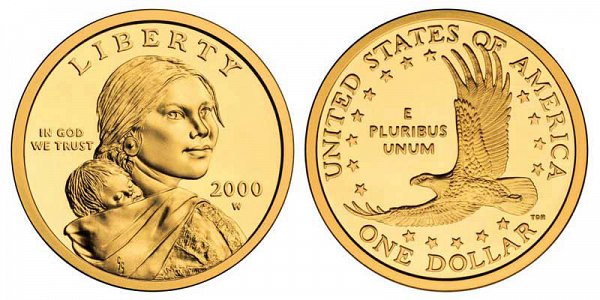Sacagawea Native American Dollar Coins
Beginning in 2000, a new one dollar coin was produced by the US Mint and is famously known as the Sacagawea Dollar. This small, golden coin depicted Sacagawea of the Native American Shoshone Tribe who helped guide the Lewis and Clark expedition. The design of the obverse (front side or heads side) of the coin was designed and sculpted by Glenna Goodacre. It depicts a portrait of Sacagawea and her child, Jean Baptiste Charbonneau. Above her portrait is the word "LIBERTY", to the left are the words "IN GOD WE TRUST" and to the right is the date and mint mark below the date. The reverse (back side or tails side) was designed by Thomas D. Rogers and depicts a flying eagle, 13 stars and the words "UNITED STATES OF AMERICA" above the eagle, "ONE DOLLAR" below the eagle, and our motto "E PLURIBUS UNUM" to the left.
This coin was minted up until 2008 with the same designs. One year before this on September 20, 2007, US President George W. Bush signed into law the Native American $1 Coin Act. This bill authorized that the Sacagawea dollar coin program would be modified to depict images that celebrate important accomplishments and contributions made by the Native American Indian tribes and individuals to the development and history of the United States of America. The bill required that the date and mintmark on the obverse of the coin be removed and the "E PLURIBUS UNUM" motto be removed from the reverse of the coin. These would then be moved to the edge of the coin where the lettered edge around the coin would also contain 13 stars, as depicted below:

An example of the lettered edge on the Sacagawea Native American Dollar Coin, produced from 2009 through the present.
The new coin series would be known as the Native American Dollar Coins. Each year, a new design would be depicted on the reverse of the coin, although the original portrait of Sacagawea would remain as the common design on the obverse of the coin throughout the series. Also, the denomination text "$1" was added to the reverse. During the design selection process, officials from the program's 3 consulting organizations: The Native American Caucus, National Congress of American Indians and United States Senate Committee on Indian Affairs, would appoint a liaison to the US Mint. After consulting with the National Museum of American Indians and Smithsonian Institution, between 12 and 15 initial designs would be selected. Then the consulting organizations would supply the US Mint with written comments and other details regarding the new themes. Suggestions are then sent to the Citizens Coinage Advisory Committee where a theme for the coin would be recommended.
Once all of the recommendations and input from organizations are reviewed, a final Native American theme is selected and finalized, and then the coin designs are created. The Native American consulting organizations and the National Museum of the Native American are then consulted after the design is complete. If approved, the design is sent to the Citizens Coinage Advisory Committee for approval there. Lastly, a final round of comments and recommendations are reviewed and the Mint will choose the final design to submit to the Secretary of the Treasury, where the coin is ultimately approved for production.
The golden Sacagawea Native American Dollar Coins is set to be produced until 2016. They will also be produced at the same time along with the golden Presidential Dollar Coins Program. By law, a minimum of at least 20% of all dollar coins produced each year must be a Native American Dollar, which is proportional for the total of 5 US dollar coin designs produced each year (4 Presidential dollars and 1 Native American dollar).
Below is a table chart listing all of the Native American dollar coins starting in 2009. Included in the table are enlargeable, high quality images, pictures and photos, the year that the coin was produced, the mintage figures for each coin and mint (referencing to prices, values and other details), design details and descriptions and the names of those who designed and sculpted/engraved the reverse of the coin for each year. This chart will continue to be updated as more designs are chosen and mintage figures are made public.
| Design Image | Year | Mintage Figures | Details | Designer / Engraver | |
|---|---|---|---|---|---|
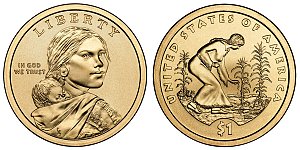 |
2009 | P: 39,200,000 D: 35,700,000 S: 2,179,867 |
Spread of Three Sisters Depicts a Native American woman spreading seeds in a field. She is planting seeds for growing corn, beans and squash on the same mound, which is an ancient Native American agricultural method of planting known as "Three Sisters". The squash plant provides ground cover to keep weeds away, the bean vines help add nitrogen into the soil and the tall corn stalks provide support for bean vines to grow. This amazingly efficient planting method increases food production by 30% or more! |
Norm Nemeth | |
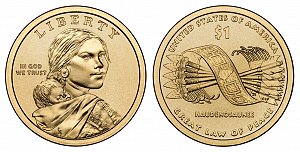 |
2010 | P: 32,060,000 D: 48,720,000 S: 1,689,216 |
Government — The Great Tree of Peace Depicts a Native American Hiawatha Belt, which represents the creation of the Haudenosaunee (Iroquois Confederacy), which five symbols on it to represent the original five Nations. On the belt, the central Great White Pine Tree is symbolic of the Onondaga Nation and the four squares represent the Mohawk, Oneida, Cayuga and Seneca tribal nations. The 5 bound arrows represent the strength of the unified Confederacy. |
Thomas Cleveland Charles L. Vickers |
|
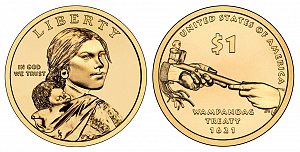 |
2011 | P: 29,400,000 D: 48,160,000 S: 1,673,010 |
Supreme Sachem Ousamequin, Massasoit of the Great Wampanoag Nation Creates Alliance with Settlers at Plymouth Bay (1621) Depicts the hand of Governor John Carver and Supreme Sachem Ousamequin Massasoit offering the ceremonial peace pipe after the first formal peace agreement and alliance between the European settlers and the Wampanoag tribe in 1692. Historians credit this alliance as being key to the survival of the Plymouth colony. |
Richard Masters Joseph Menna |
|
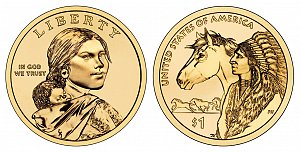 |
2012 | P: 2,800,000 D: 3,080,000 S: 1,189,445 |
Trade Routes in the 17th Century Depicts a Native American and his horse with other running horses in the background, which represents the historical spread of the horse. The Native American Indians had maintained the trans-continental trade routes for over a thousand years, the same routes that helped the early European settlers explore, settle and trade within the mainland. |
Thomas Cleveland Phebe Hemphill |
|
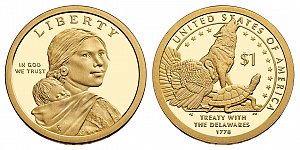 |
2013 | P: 1,820,000 D: 1,820,000 S: 1,192,690 |
The Delaware Treaty (1778) Depicts a turtle, turkey and a howling wolf. The three symbolize the clans of the Native American Delaware Tribe. After the United States declared independence, the Delaware Treaty was signed with the Delaware Indian Tribe at Fort Pitt in Pittsburgh, Pennsylvania on September 17, 1778. 13 stars are also depicted on the coin to represent the 13 Colonies of the United States. |
Susan Gamble Phebe Hemphill |
|
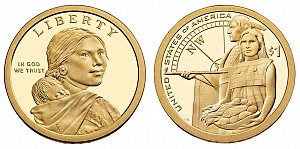 |
2014 | P: 5,600,000 D: 3,080,000 D Enhanced Finish: 50,000 S: 1,144,190 |
Native Hospitality The full theme of this dollar coin is: "Native Hospitality Ensured the Success of the Lewis and Clark Expedition". Depicted on this coin is a Native American man offering in hospitality, a pipe and his wife offering food, which includes fish, gourd, corn and roots. On the background of this coin depicts the letters "NW" on a compass, denoting the Northwest direction and bearing of the Lewis and Clark expedition. |
Chris Costello Joseph Menna |
|
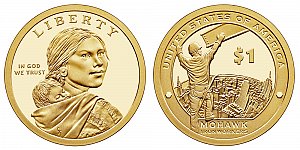 |
2015 | P: 2,800,000 D: 2,240,000 S: 1,050,394 W Enhanced Finish: 88,805 |
Mohawk Ironworkers The full theme of this dollar coin is: "Mohawk high iron workers, builders of New York City and other skylines (from 1886)". Depicted on the reverse is a Mohawk Ironworker reaching for a swinging iron I-beam with the city skyline in the background. Also depicts the words "Mohawk Ironworkers" and two rivets at the outer edge of the design. |
Ronald D. Sanders Phebe Hemphill |
|
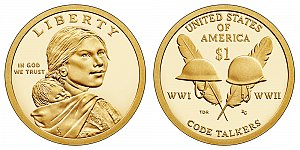 |
2016 | P: 2,800,000 D: 2,100,000 S: 965,093 S Enhanced Finish: 50,740 |
Code Talkers The full theme of this dollar coin is: "Code Talkers from both World War I and World War II (1917-1945)". Depicted on the reverse of the coin are two helmets - one from WWI and the other from WWII. In the background are two feathers in "V" shape - symbolizing victory and unity. This commemorates the importance of Native American code talkers and their role in helping to win both World Wars. |
Thomas D. Rogers, Sr. Renata Gordon |
|
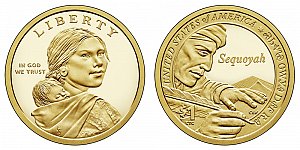 |
2017 | P: 1,820,000 D: 1,540,000 S Enhanced Uncirculated: 223,310 S: 926,786 |
Sequoyah The full theme of this dollar coin is: "Sequoyah from Cherokee Nation". The reverse of the coin features a depiction of Sequoyah writing the words "Sequoyah from Cherokee Nation" in Cherokee language. This coin commemorates Sequoyah, who is known for creating the Cherokee language and Syllabary. |
Chris Costello Charles L. Vickers |
|
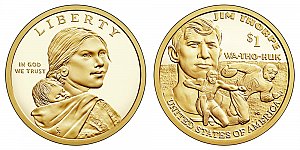 |
2018 | P: 1,400,000 D: 1,400,000 S Proof: 849,356 S Reverse Proof: 199,177 |
Jim Thorpe The theme of this coin is "Jim Thorpe", legendary sports athlete. The reverse of the coin depicts Native American Jim Thorpe and highlights his achievements in football and the Olympics. The word "WA-THO-HUK" is struck on the coin, which is Thorpe's Sac and Fox tribe name. |
Michael Gaudioso | |
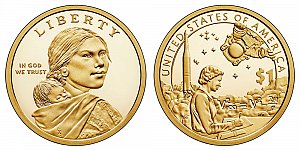 |
2019 | P: 1,400,000 P Enhanced Uncirculated: 46,964 D: 1,540,000 S Proof: 1,107,748 |
American Indians in the Space Program The theme for this coin is "American Indians in the Space Program". The reverse of the coin depicts Native American Mary Golda Ross (Cherokee Nation) writing mathematical space flight calculations. Depicted in the background is an Atlas-Agena rocket launching with an equation in it's exhaust cloud. The equation represents the amount of energy it takes a rocket to leave Earth. Also depicted is an astronaut, which symbolizes Native American astronauts, including John Herrington (Chickasaw Nation), conducting a space walk among a field of stars. |
Emily Damstra Joseph Menna |
|
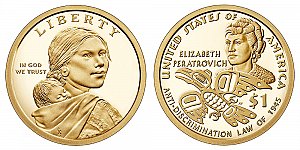 |
2020 | P: 1,400,000 D: 1,260,000 S Proof: 777,841 |
Elizabeth Peratrovich - Anti-Discrimination Law Of 1945 The theme for this coin is "Elizabeth Peratrovich and Alaska's Anti-Discrimination Law Of 1945". The reverse of the coin depicts a portrait of Elizabeth Peratrovich, who was instrumental in passing the 1945 Anti-Discrimination Law in the Alaskan Territorial Government. Her advocacy was a deciding factor in getting this law pass. This law is also the first anti-discrimination law passed in the United States - a law that prohibits discrimination in access to public accommodations. Also depicted on the coin is the symbol of the Tlingit Raven moiety, the tribe in which she was a member of. |
Phebe Hemphill | |
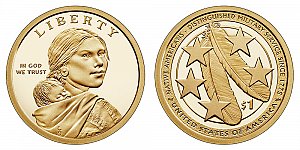 |
2021 | P: 1,260,000 D: 1,260,000 S Proof: 814,977 |
Native Americans - Distinguished Military Service Since 1775 The theme for this coin is "Native Americans - Distinguished Military Service Since 1775". The reverse depicts eagle feathers, which were traditionally earned in battle or performing a brave deed. Eagle feathers are revered and respected, proudly displayed in homes and they receive great care and handling. Also depicted are five stars, representing the five branches of the US Military. The circle also provides additional reference to Native Americans. |
Donna Weaver Joseph Menna |
|
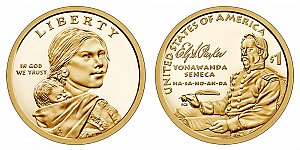 |
2022 | P: 980,000 D: 980,000 S Proof: 647,404 |
Native Americans - Ely S. Parker The theme for this coin is "Native Americans - Ely S. Parker". The reverse depicts Civil War era Ely Samuel Parker in army uniform with a quill pen in hand. The reverse depicts his elegant signature. Also depicted are the words "TONAWANDA SENECA", which is his tribe's name and "HA-SA-NO-AN-DA", which is his birth name. When Confederate General Robert E. Lee surrendered on April 9, 1865 in Appomattox, Virginia, the formal surrender documents were rendered by hand by Ely S. Parker. |
Paul C. Balan Joseph Menna |
|
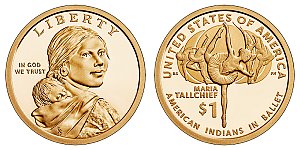 |
2023 | P: 1,120,000 D: 1,120,000 S Proof: 551,448 |
Maria Tallchief and American Indians in Ballet The theme for this coin is "Maria Tallchief and American Indians in Ballet". Maria Tallchief is considered America’s first major prima ballerina. She is also the first Native American (Osage Nation) to hold the rank. In addition, her younger sister Marjorie Tallchief, and Yvonne Chouteau, Rosella Hightower, and Moscelyne Larkin - all Native Americans from Oklahoma - became internationally recognized. They were celebrated as "Five Moons" and their legacy of achievement still influences ballet today. The reverse of this coin depicts Maria Tallchief in balletic pose. The background also depicts the lunar motif and four ballerinas, which is a nod to the "Five Moons", Tallchief’s American Indian ballerina contemporaries the generations of dancers that they inspire. In addition to the Sacagawea Dollar, Maria Tallchief is also honored in the 2023 Maria Tallchief American Women Quarters. |
Benjamin Sowards Phebe Hemphill |
|
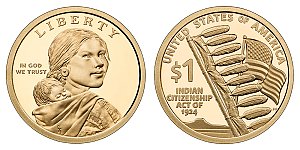 |
2024 | P: N/A D: N/A S Proof: N/A |
Indian Citizenship Act of 1924 The theme for this coin is "Indian Citizenship Act of 1924". It was signed into law on June 2, 1924 and grants US citizenship to all non-citizen Indians born within the territorial limits of the United States. This law also did not require American Indians to give up their tribal citizenship, allowing them to preserve their tribal identity and communal tribal property. The reverse of the coin depicts an eagle staff, which is a symbol of respect, honor and patriotism. Also depicted is the American flag, which represents the dual citizenship. |
Phebe Hemphill |
